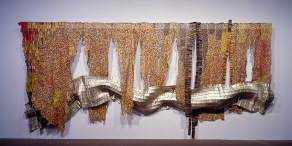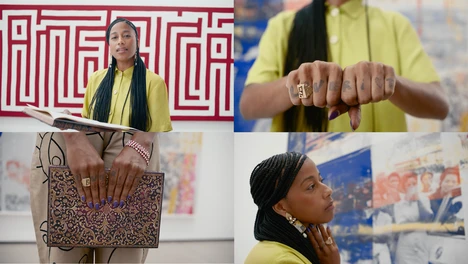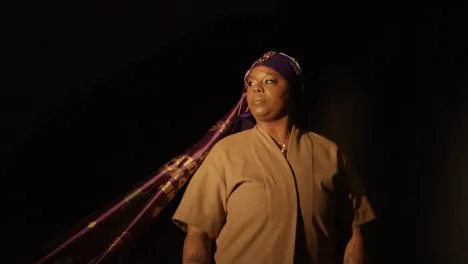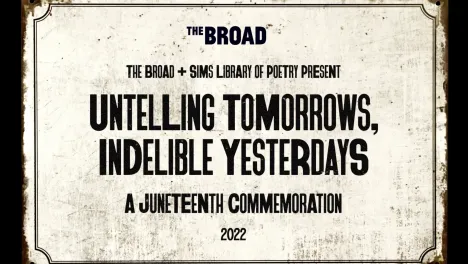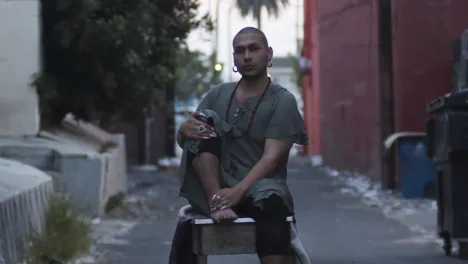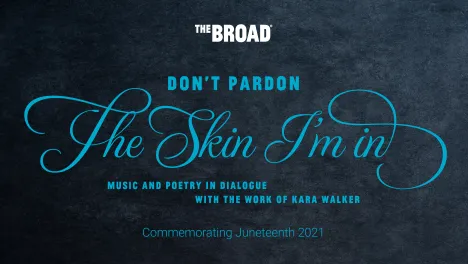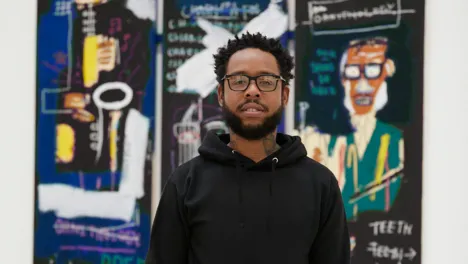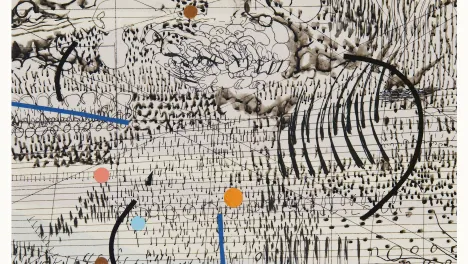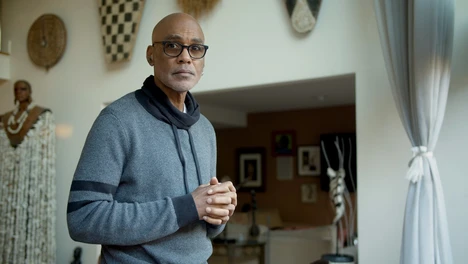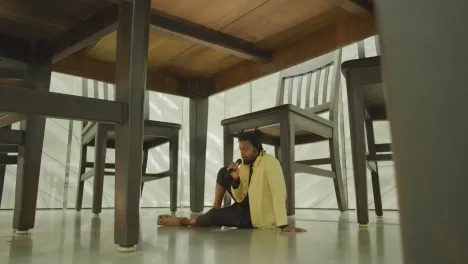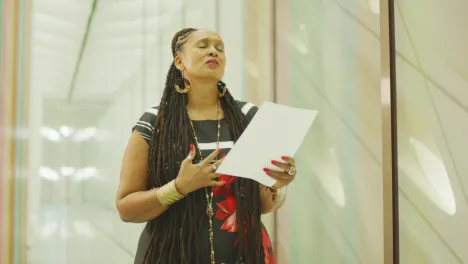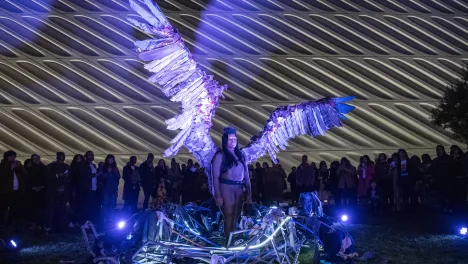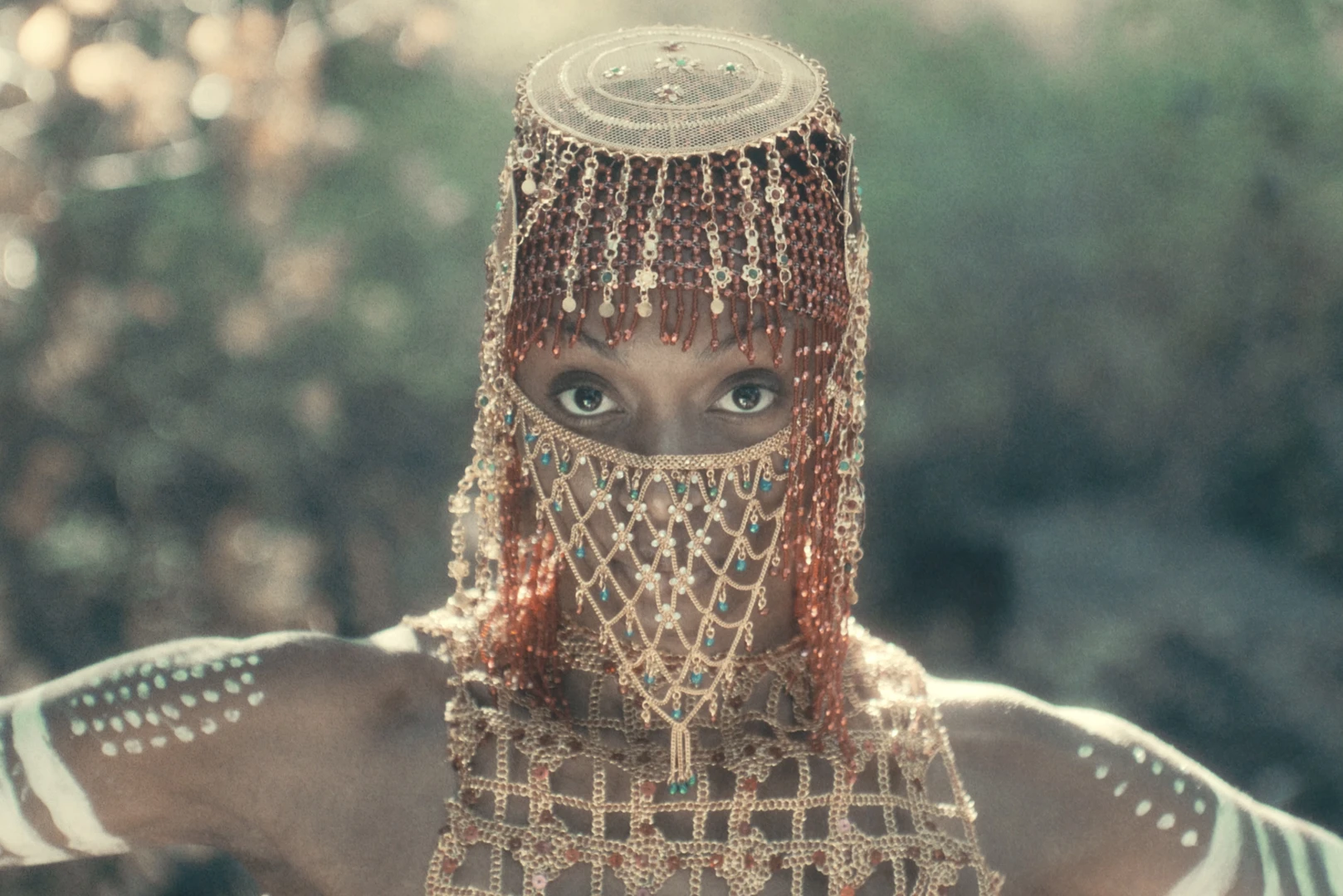
Children of the Soil: M’Baye Kante and Haniyyah Tahirah respond to El Anatsui’s Strips of the Earth’s Skin
Overview
In observance of Earth Day 2023, The Broad commissioned musician M’Baye Kante and dancer Haniyyah Tahirah to produce Children of the Soil, an original performance for video in response to Broad collection artist El Anatsui’s Strips of Earth’s Skin. Born in Ghana and based in Nigeria, Anatsui crafts bottle caps, reused aluminum commercial packaging, copper wire, and other materials into giant shimmering sheets of what he calls “cloths.” The aesthetic properties and the deeper meaning behind Anatsui’s work—such as consumerism, colonialism, the environment, and waste—are reflected and interpreted by Kante and Tahirah through original text, music and vocals, costume, and lush cinematography. Earth Day is observed annually on April 22 and marks the birth of the modern environmental movement in 1970.
Found aluminum and copper wire.
The Broad Art Foundation. (c) El Anatsui
Children of the Soil
We all are children of the soil. Each of us share a common link that connects us to the first human beings that walked and migrated upon the earth and who evolved into the vast diversity of humanity as we see it today. Throughout the beauty of our universe and nature’s creation, there is a constant dance between the masculine and feminine
energies. In essence, we need each other, our very existence depends on this principle.
The elements of nature—sun/fire, water, earth, and air—are all manifestations of masculine and feminine energies that give life to all vegetation which in turn nourishes and sustains human and animal life as we know it.
The hardships and sorrows of the world can only be combated by the symbiosis of both energies working together and complementing one another. Each of us has a divine part of the answer that lies within us; it is what our world so desperately needs. We all need to tap into Mother Earth, the universe, and each other. We are all interdependent.
Children of the Soil is inspired by the work of Ghanaian-born artist El Anatsui’s work Strips of the Earth's Skin. He found meaning through his country’s trials and tribulations and created timeless artistic beauty out of the “reuse, transformation, and an intrinsic desire to connect to his continent while transcending the limitations of place.” His work addresses the history of colonialism in Africa and its direct connection to consumption, waste, and the environment as it is today. Many of El Anatsui’s sculptures contain thousands of pieces of aluminum bottle caps sourced from local alcohol recycling stations in Nigeria and Ghana connected with copper wire. We, as children of the soil, must connect and fuse back to Mother Earth and the universe to find our inner peace. El Antasui did just that and he tapped into that creative gift within himself. Digging into his Indigenous culture and environment, using the refuse of colonialism to create something beautiful and transcendent.
The black mask in the beginning of the film represents the void, the darkness of the universe, the omnipresent. As Kante plays the Kora, he is the embodiment of the omnipresent, the frequency of sound, a spark of life in the darkness. Tahirah represents mother earth and the embodiment of the forces of nature as she emerges, reacting to the sound of the omnipresent. The universe gives the earth rain and sun. She creates flowers and trees of life. The omnipresent gives her strings, she creates words. The omnipresent gives her the rhythm of drums she in turn creates dance.
We live in times that influence us to be alone and disconnected from ourselves, each other, and the environment. When we tap in and arm ourselves with the energies of mother earth and delving into the universe in ourselves. As we come back to mother earth, we come back to ourselves. There is much to learn within the vastness of nature, life, and death. As the embodiment of mother earth deity submerges herself in the water she represents, and the end of life transitions into the beginning once again.
—M'Baye Kante and Haniyyah Tahirah
Details

M'Baye Kante
Originally from Brooklyn, New York, M’Baye Kante is an accomplished artist with over 10 years of professional experience. He is a percussionist of the djembe and dundun drums in addition to playing the kora, a 21-stringed instrument originating from the Malian Empire in the 12th century. He also has modeled for world renowned agency Ford models in New York. He currently devotes his time cultivating and educating youth on West African culture through music, art, and dance. Apprenticing under master Senegalese percussionist Malick Sow, in addition to being a musician for The Music Center, Kante has performed throughout schools and universities all over California, conducting numerous workshops and educational performances that highlight the connection between West African indigenous music and modern music as it is today. Kante is also a filmmaker whose film Da Djembe Lives won an award for Best Documentary in the Compton Film Festival. Collectively, Kante and Haniyyah Tahirah have created and performed original work entitled Wideke 11 that premiered exclusively at the Broad’s Fourth Fridays with Intermittent Signals by Ghanaian-born artist El Anatusi. Most recently, they conducted a community West African drum and dance class at The Broad’s Family Weekend Workshops. Most recently M’Baye worked with actor and director Richard Lawson in the upcoming film Black Terror. M’Baye Kante also is the live percussionist for Tahirah’s Modern d\Dance class at Gravity Dance Company in Long Beach.
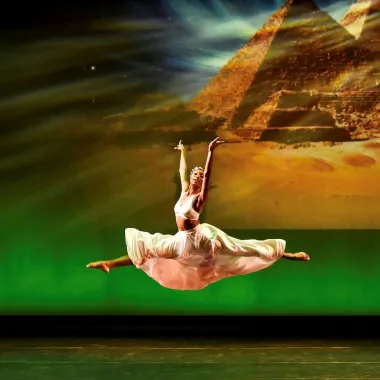
Haniyyah Tahirah
Haniyyah Tahirah is a Los Angeles native, professional dancer, choreographer, and dance instructor with over 15 years of experience. Trained in ballet, modern, jazz, West African, and Afro-Brazilian dance, Tahirah worked as a principal dancer and soloist for over 12 years with the internationally acclaimed Lula Washington Dance Theatre performing all over the U.S., as well as in Russia, China, Brazil, and Israel. She has performed as a guest artist with Viver Brasil Dance Co. and the Las Vegas Contemporary Dance Theatre. Tahirah has also worked with Tony Award winner George Faison in addition to working as a motion-capture artist in the making of the 2009 blockbuster film Avatar directed by James Cameron. Collectively, Haniyyah Tahirah and M’Baye Kante have created and performed original work entitled Wideke 11 that premiered exclusively at the Broad’s Fourth Fridays with Intermittent Signals by Ghanaian-born artist El Anatusi. Most recently they conducted a community West African drum and dance class at The Broad’s Family Weekend Workshops. Tahirah also teaches at Gravity Dance Company in Long Beach where Kante is the percussionist for her modern dance class. Haniyyah Tahirah continues to teach dance and body awareness to her students, both youth and adults, while still cultivating her many skills and artistic talents.
